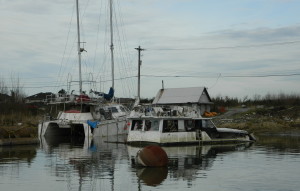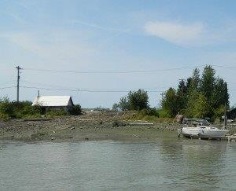Environment: Tampa, Port Metro Vancouver
![]() Print this Article | Send to Colleague
Print this Article | Send to Colleague
Port Tampa Bay: Completing Projects, Protecting Nesting Birds
This spring and summer, important projects that support shipping activities and enhance bay habitat were completed on the two dredge material management areas in Hillsborough Bay under the oversight of the Migratory Bird Protection Implementation Committee, thanks to the close collaboration of multiple agencies, including Port Tampa Bay.
"Our collaborative partners, working together to manage the work on islands identified by the FWC (Florida Fish and Wildlife Conservation Commission) and BirdLife International as 'globally significant' for birds, resulted in projects being successfully accomplished while the nesting birds remained undisturbed," Chris Cooley, Port Tampa Bay’s environmental affairs director, said. "We feel that this cooperation is key to keeping port activities on schedule."
"There was a lot going on this nesting season on the dredge disposal islands of Tampa Bay," added Cindy Fury, Wildlife Biologist with the U.S. Fish and Wildlife Service’s Florida/Caribbean Migratory Bird Field Office. "Our Committee reviewed the projects in advance, and because all the contractors involved followed the recommendations we developed, the projects were accomplished safely for the birds and also for people."
The projects included dredging of the Big Bend Shipping Channel by Tampa Electric Company (TECO).
"Working with the Migratory Bird Protection Implementation Committee was key to getting permission to immediately begin the dredging that allowed safer movement of our ships into the power plant facility at Big Bend," said Kristy Apostol, TECO’s environmental health and safety engineer. The silty material was piped into the northern of the two large disposal islands starting in April. Audubon’s sanctuary manager, Mark Rachal, worked closely with the contractor. "We surveyed the island shoreline and found a section where American Oystercatchers were not nesting. This allowed us to bring the dredge pipe onshore without impacting nesting birds," Rachal said.
The National Oceanic and Atmospheric Administration (NOAA) oversaw installation of an oyster reef habitat creation project on the east side of Island 2D, the northern dredge material management island. This project was funded by fines resulting from the 1998 Mulberry Phosphate acid spill. Three linear limestone rock bars stretching a total of 1,400 feet were installed close to the island’s eastern shore to offset oyster habitat lost during the acid spill.
"Immediately after the limestone oyster bars were installed, they were full of small marine animals, including thousands of tiny crabs, and birds began to forage on the bars right away," stated NOAA’s Jeanie Jennings.
The Army Corps of Engineers has been working through two nesting seasons on a large-scale project to raise the dikes on the southern of the two dredge material management areas (Island 3D) in Hillsborough Bay.
Lead engineer for the Corps Andy Cummings said: "Our activities included clearing and excavating portions of the island interior, which promoted shorebird nesting on DMMA 3D. Extensive coordination with the MBPIC and our contractor, Carter's Contracting Services, allowed us to ensure this major construction work was carried out without endangering any birds or their chicks."
The official nesting season runs from April 1 through August 31 and represents a cooperative effort between the port authority, Audubon Florida, the U.S. Army Corps of Engineers, the Florida Fish and Wildlife Conservation Commission, and other local, state, and federal agencies to protect the nesting birds.
The islands provide protected nesting habitat for American Oystercatchers and many other sea bird species to complete their reproductive cycle. Each year, the islands become one of the bay area’s prime nesting sites, hosting as many as 1,000 nesting migratory birds.
"This year saw nesting by over 40 pairs of oystercatchers, over 450 pairs of gulls, four species of terns, and about 55 pairs of Black Skimmers," reported Mark Rachal.
The nesting population of oystercatchers on the dredge disposal islands is the largest in the state, according to surveys conducted by Audubon and the Florida Fish and Wildlife Conservation Commission. Oystercatchers remain one of Florida’s rarest species, with less than 400 pairs in Florida. In addition, more than 450 Black-bellied Whistling-Duck ducklings were observed on Island 3D.
"Audubon appreciates the cooperation of Port Tampa Bay, the Army Corps of Engineers, the general boating public, and others as we jointly strive to protect the water birds that nest in large numbers on the dredge disposal islands," said Ann Paul, Audubon staff biologist.
Working closely with key partners, the port authority has an integral role in the restoration, improvement and protection of the environmental health of Tampa Bay.
"In keeping with a firm commitment to the health and vitality of the waters around Tampa Bay and the native species that thrive there, we at the port will continue to engage in meaningful, long-term initiatives that sustain and improve life in these delicate habitats," said Port Tampa Bay CEO Paul Anderson.
Port Metro Vancouver Updates Progress on Fraser River Cleanup Program
Port Metro Vancouver has so far addressed 118 of 151 sites identified in the Fraser River Improvement Initiative, a program to clean up municipal waterways and shipping channels.
Derelict vessels, abandoned boats, and structures like old docks can be safety risks, create pollution, and are unsightly. By law, they are the owner’s responsibility, which can make them difficult to resolve. The resolution of these sites often solves long-standing safety, environmental and community concerns.
The initiative targets neglected vessels and structures that pose risk to wildlife or natural habitats, or impede navigational safety on the Fraser River, such as vessels that are sinking or leaking fuel. Port Metro Vancouver starts by trying to contact owners and, where possible, work with them to ensure safe removal. The port authority has committed approximately C$2 million over five years to the initiative, which began in 2013.
"These sites can be an environmental or navigational hazard on the river, and can lessen the quality of life in local communities," said Tom Corsie, Vice President of Real Estate at Port Metro Vancouver. "We are proud of the progress we’ve made in improving the river and ensuring owners take appropriate responsibility for their vessels or property."
Recent sites that have been addressed under the program include several vessels on the shores of the Annacis Channel in New Westminster, such as an abandoned catamaran and power boat that were embedded in the shore, causing considerable public concern and creating the potential for environmental damage. Another resolved site required removal of piles in Gunderson Slough in Delta, ultimately benefitting the intertidal marsh habitat in the area, navigation and public safety.


Annacis Channel before and after the cleanup.
Photos/Port Metro Vancouver

